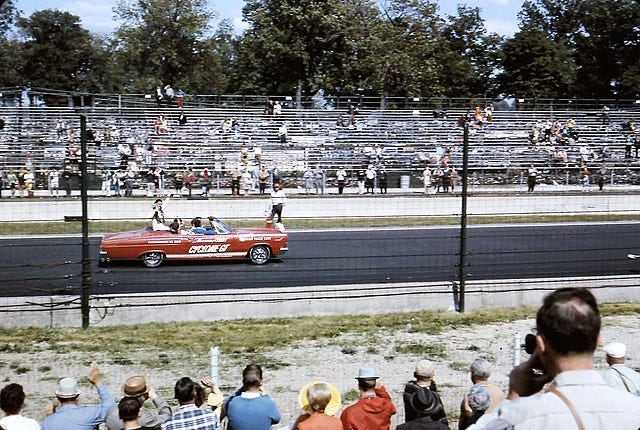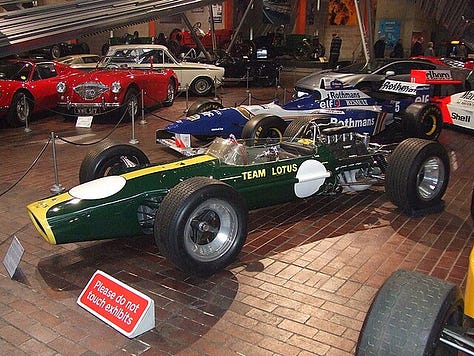As briefly mentioned in my post from April 7th introducing the history of IndyCar and its basic distinctions from Formula 1, the crown jewel event of the IndyCar calendar used to be a concomitant part of the F1 calendar.
Is the Indy 500 NASCAR? Or F1?
I can’t even tell you how many friends, colleagues, and even family members have responded to my saying I was an intern at the Indy 500 with “That’s like, NASCAR, right?” A handful of them have even …
In the 1950’s and 1960’s, Formula 1 cars raced at the Indianapolis 500 Mile Race, which is among the most prestigious racing events in the world and has been a coveted victory since its inaugural race in 1911.
This was an odd arrangement, even for the time. It was only added to the F1 calendar because the FIA wanted Formula 1 to live up to its international aspirations. Plus, the Indy 500 was already 39 years old by 1950 and was a popular event in its own right. Easy fan base to access, so the FIA thought. Turns out, the FIA didn’t think very hard.
None of the “regular” Formula 1 drivers joined the Indy 500 in 1950. The cars that raced at Indy at the time (and currently) are quite distinct from F1 cars. Teams were unwilling to design a one-off racecar for a race that, if all the regular F1 drivers skipped, wouldn’t have a strong effect on the championship. In 1950, that’s exactly what happened - not a single F1 driver raced in Indy. The only manufacturer that had cars at the 500 and the rest of the F1 Grands Prix was Maserati, and they didn’t do very well. The Indy Maserati drivers Henry Banks and Spider Webb (Indy drivers have the best names) finished in 25th and 19th respectively.1 Maserati is, however, the first and only Italian manufacturer to win at Indy, in 1939 and 1940.2
For 11 years, the Indy 500 sat on the F1 calendar, mostly neglected by the F1 regulars. In 1952 Ferrari tried to bring the power of the prancing horse to The Greatest Spectacle in Racing but ended up bringing a mule, four of them in fact. Alberto Ascari, the third-ever Formula 1 World Champion, was the only Ferrari driver of four entrants to qualify for the 500. He started the race in 19th place and was out on the 25th lap due to a wheel failure.3 Juan Manuel Fangio, often considered the greatest Formula 1 driver of the twentieth century, failed to qualify for the 1958 Indy 500. This is the motorsport equivalent of Steph Curry missing a free throw.
Eventually, the FIA gained hold of its senses and decided to remove the 500 from the F1 calendar. Ironically, it was after this change that F1 drivers started to more regularly appear in Indianapolis, driving for other teams with better equipment for the Brickyard.

The only Formula 1 champions to win the Indy 500 are Jim Clark, Graham Hill, Mario Andretti, Emerson Fittipaldi, and Jacques Villeneuve. One caveat is that Mario Andretti won the Indianapolis 500 in 1969, before he had even started racing in F1. I plan to profile all of the most legendary drivers of Formula 1 in future articles, so be sure to subscribe to learn about the most important figures in racing.
On the surface, these facts about the F1/Indy 500 overlap seem like fun motorsport trivia. But this period was seminal in the development of the two sports. In the 1950’s, F1 was a new entity and working to identify itself as the premier motorsports league by getting its drivers to compete in the most prestigious races in the world. It’s a surprise we never saw an F1 / Le Mans overlap during this early stage, as Le Mans is considered the third jewel in the “Triple Crown” of motorsport alongside the Monaco Grand Prix and the Indianapolis 500. Today, the cars that race at Le Mans are so completely different from Formula 1 that such a crossover would be impossible. But back then, things were a bit more flexible. Regardless, the world of Formula 1 did have a profound effect on the types of cars that race at Indy.
In the 1950’s, racecars were beefy machines with the engine located at the front of the car, like the average road car. A British man named Colin Chapman changed everything when he introduced his lightweight and unbeatably nimble cars to the F1 field. He called his car manufacturer Lotus. Today, Lotus is focused on building stylish sports cars, but in the 1960’s and 70’s Lotus was a persistent champion in Formula 1. The Lotus F1 team won seven constructors’ championships and six drivers’ championships. The last Lotus-powered F1 champion was the Mario Andretti, F1 World Champion of 1978.
When Colin Chapman decided to try sending one of his lightweight, cigar-shaped beasts to the Indy 500 in 1963, his main man, Jim Clark of Scotland, came in second place. Lotus won the Indy 500 in 1965 in dominant fashion. The Lotus cars driven by Jim Clark and AJ Foyt qualified first and second by a comfortable margin. The two Lotus cars led every single lap of the race, with Jim Clark leading 190 of 200 and AJ Foyt rounding out the other 10.4 The rest of the field at Indy got the message loud and clear. If you weren’t racing a mid-engined car like Colin Chapman’s lads, then you were going to lose.



The last Formula 1 champion to win the Indy 500 was Jacques Villeneuve in 1995. But the last former F1 driver to win the Indy 500 was Marcus Ericsson in 2022. Takuma Sato, also a former F1 driver, won the 500 in 2017 and 2020. While the Indy 500 will never again be on the Formula 1 calendar, there’s still plenty of cross-pollination between IndyCar and Formula 1, and that’s a good thing for us spectators.
As far as the next F1 champion to win at the Indy 500, that’s anyone’s guess. Personally, I find it unlikely that Lewis Hamilton or Sebastian Vettel would give it a shot. While Max Verstappen has said he has no desire to race at the Indy 500, finding it too dangerous, I still wouldn’t be surprised if ten years from now we see him racing around the Brickyard.5 At the very least, it would be great to see more former F1 stars join the festivities of Indy 500 race day. I believe that any F1 champions who join the race as a spectator will eventually end up racing. Indy pulls at your soul like that. The only problem is that the prestigious Monaco Grand Prix is typically the same weekend as the 500, so F1 drivers are unavailable to participate or watch.
In sum, the connection between the Indianapolis 500 and Formula 1 has changed significantly over the past seven decades. But with recent Indy 500 victories from former F1 drivers and increased American interest in Formula 1 and IndyCar, I sense a coming golden age of Indy 500 competition driven by increased international interest in the event, assuming any non-Americans want anything to do with us by the end of President Trump’s term.




